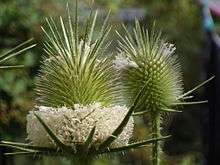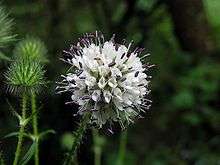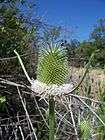Dipsacus
| Dipsacus | |
|---|---|
 | |
| Dipsacus fullonum | |
| Scientific classification | |
| Kingdom: | Plantae |
| (unranked): | Angiosperms |
| (unranked): | Eudicots |
| (unranked): | Asterids |
| Order: | Dipsacales |
| Family: | Caprifoliaceae |
| Subfamily: | Dipsacoideae |
| Genus: | Dipsacus L. |
| Species | |
|
See text. | |
Dipsacus is a genus of flowering plant in the family Caprifoliaceae.[1] The members of this genus are known as teasel, teazel or teazle. The genus includes about 15 species of tall herbaceous biennial plants (rarely short-lived perennial plants) growing to 1–2.5 metres (3.3–8.2 ft) tall. Dipsacus are native to Europe, Asia and northern Africa.
The genus name is derived from the word for thirst of water and refers to the cup-like formation made where sessile leaves merge at the stem. Rain water can collect in this receptacle; this may perform the function of preventing sap-sucking insects such as aphids from climbing the stem. A 2011 experiment has shown that adding dead insects to these cups increases the seedset of teasels (but not their height), implying partial carnivory.[2] Carnivory in teasels was discussed by Francis Darwin (son of Charles Darwin) in a paper held by The Royal Society.[3] The leaf shape is lanceolate, 20–40 centimetres (7.9–15.7 in) long and 3–6 centimetres (1.2–2.4 in) broad, with a row of small spines on the underside of the midrib.
Teasels are easily identified with their prickly stem and leaves, and the inflorescence of purple, dark pink or lavender flowers that form a head on the end of the stem(s). The inflorescence is ovoid, 4–10 centimetres (1.6–3.9 in) long and 3–5 centimetres (1.2–2.0 in) broad, with a basal whorl of spiny bracts. The first flowers begin opening in a belt around the middle of the spherical or oval flowerhead, and then open sequentially toward the top and bottom, forming two narrow belts as the flowering progresses. The dried head persists afterwards, with the small (4–6 millimetres (0.16–0.24 in)) seeds maturing in mid autumn.
The seeds are an important winter food resource for some birds, notably the European goldfinch. Teasels are often grown in gardens and encouraged on some nature reserves to attract them.[4]
Teasel is also considered an invasive species in the United States. It is known to form a monoculture, capable of crowding out all native plant species, and therefore is discouraged and/or eliminated within restored open lands and other conservation areas.[5][6][7]
Species
Selected Dipsacus species:
- Dipsacus ferox – spiny teasel
- Dipsacus fullonum – wild teasel, common teasel, fuller's teasel
- Dipsacus japonica – Japanese teasel, Chinese teasel
- Dipsacus laciniatus – cut-leaved teasel
- Dipsacus pilosus – small teasel
- Dipsacus sativus – fuller's teasel (cultivated form)
- Dipsacus strigosus – slim teasel
- etc.
| Flowerheads | ||||||||||
|---|---|---|---|---|---|---|---|---|---|---|
|
Cultivation and uses
Fuller's teasel (the cultivar group Dipsacus fullonum Sativus Group; syn. D. sativus) was formerly widely used in textile processing, providing a natural comb for cleaning, aligning and raising the nap on fabrics, particularly wool.[8] It differs from the wild type in having stouter, somewhat recurved spines on the seed heads. The dried flower heads were attached to spindles, wheels, or cylinders, sometimes called teasel frames, to raise the nap on fabrics (that is, to tease the fibres).[9] By the 20th century, teasels had been largely replaced by metal cards, which can be made uniformly and do not require constant replacement as the teasel heads wear. However, some people who weave wool still prefer to use teasels for raising the nap, claiming that the result is better; in particular, if a teasel meets serious resistance in the fabric, it will break, whereas a metal tool will rip the cloth.
Teasels are also occasionally grown as ornamental plants, and the dried heads are used in floristry.

Teasels have been naturalised in many regions away from their native range, partly due to the import of fuller's teasel for textile processing, and partly by the seed being a contaminant mixed with crop seeds.
Common teasel (Dipsacus fullonum) and cut-leaved teasel (Dipsacus laciniatus) have both been observed as invasive species in the United States. Common is more widespread, but cut-leaved is more aggressive.
Due to the chemical dipsacus saponin C, Dipsacus asper has medically significant procoagulant properties, likely due to an increase of intra-cellular calcium, and apoptosis of mitochondria.[10] This presents a considerable risk to the average user but may be beneficial in certain cirumstances.[11]
Phytochemistry
Ethanol extracts of Dipsacus asper contain phenolic acids including caffeic acid, 2,6-dihydroxycinnamic acid, vanillic acid, 2′-O-caffeoyl-D-glucopyranoside ester, and caffeoylquinic acid, iridoid glucosides, triterpenoids oleanic acid and akebiasaponin D.[12]
References
- ↑ "Dipsacus", The Plant List (version 1.1), retrieved 2014-09-19
- ↑ Shaw, P. J. A.; Shackleton, K. (2011). Joly, Simon, ed. "Carnivory in the teasel Dipsacus fullonum — the effect of experimental feeding on growth and seed set". PLoS ONE. 6 (3): e17935. PMC 3060873
 . PMID 21445274. doi:10.1371/journal.pone.0017935.
. PMID 21445274. doi:10.1371/journal.pone.0017935. - ↑ Mentioned in episode of Objectivity (2016-05-31), White Gloves of Destiny (Random Researcher) - Objectivity #72, retrieved 2016-05-31
- ↑ "Advice from the Royal Society for the Protection of Birds on how to attract Goldfinch to your garden with teasel". Retrieved October 16, 2011.
- ↑ "Invasive Species: Plants – Common Teasel (Dipsacus fullonum)". Retrieved October 16, 2011.
- ↑ "Invasive Species – Common Teasel (Dipsacus fullonum subsp. sylvestris)". Archived from the original on November 12, 2011. Retrieved October 16, 2011.
- ↑ "Common and Cut-Leaved Teasel Control". Archived from the original on July 12, 2011. Retrieved October 16, 2011.
- ↑ "Teasel." The Oxford English Dictionary. 2nd ed. 1989.
- ↑ "Teasel Handles and Teasel Gigs in the Trowbridge Museum". Retrieved January 16, 2013.
- ↑ Song JS, Lim KM, Kang S, Noh JY, Kim K, Bae ON, Chung JH (May 10, 2012). "Procoagulant and prothrombotic effects of the herbal medicine, Dipsacus asper and its active ingredient, dipsacus saponin C, on human platelets.". Journal of Thrombosis and Haemostasis. PMID 22405282.
- ↑ UW Health. "Procoagulant Therapy for Bleeding Associated with Acquired Bleeding Disorders Adult Inpatient Clinical Practice Guideline" (PDF).
- ↑ Tian, XY. "On the chemical constituents of Dipsacus asper". Chem Pharm Bull (Tokyo). 55: 1677–81. PMID 18057739.
| Wikimedia Commons has media related to Dipsacus. |


